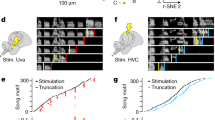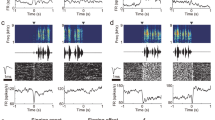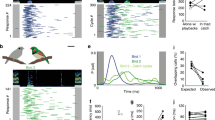Abstract
The pallido-recipient thalamus transmits information from the basal ganglia to the cortex and is critical for motor initiation and learning. Thalamic activity is strongly inhibited by pallidal inputs from the basal ganglia, but the role of nonpallidal inputs, such as excitatory inputs from cortex, remains unclear. We simultaneously recorded from presynaptic pallidal axon terminals and postsynaptic thalamocortical neurons in a basal ganglia–recipient thalamic nucleus that is necessary for vocal variability and learning in zebra finches. We found that song-locked rate modulations in the thalamus could not be explained by pallidal inputs alone and persisted following pallidal lesion. Instead, thalamic activity was likely driven by inputs from a motor cortical nucleus that is also necessary for singing. These findings suggest a role for cortical inputs to the pallido-recipient thalamus in driving premotor signals that are important for exploratory behavior and learning.
This is a preview of subscription content, access via your institution
Access options
Subscribe to this journal
Receive 12 print issues and online access
$209.00 per year
only $17.42 per issue
Buy this article
- Purchase on Springer Link
- Instant access to full article PDF
Prices may be subject to local taxes which are calculated during checkout






Similar content being viewed by others
References
Graybiel, A.M. The basal ganglia: learning new tricks and loving it. Curr. Opin. Neurobiol. 15, 638–644 (2005).
Reiner, A. You cannot have a vertebrate brain without a basal ganglia. in The Basal Ganglia IX (eds. Groenewegen, H.J., Voorn, P., Berendse, H.W., Mulder, A.B. & Cools, A.R.) 3–24 (Springer, New York, 2009).
Hikosaka, O. GABAergic output of the basal ganglia. Prog. Brain Res. 160, 209–226 (2007).
Chevalier, G. & Deniau, J.M. Disinhibition as a basic process in the expression of striatal functions. Trends Neurosci. 13, 277–280 (1990).
DeLong, M.R. Primate models of movement disorders of basal ganglia origin. Trends Neurosci. 13, 281–285 (1990).
Kultas-Ilinsky, K., Sivan-Loukianova, E. & Ilinsky, I.A. Reevaluation of the primary motor cortex connections with the thalamus in primates. J. Comp. Neurol. 457, 133–158 (2003).
Albin, R.L., Young, A.B. & Penney, J.B. The functional anatomy of basal ganglia disorders. Trends Neurosci. 12, 366–375 (1989).
Strick, P.L. Activity of ventrolateral thalamic neurons during arm movement. J. Neurophysiol. 39, 1032–1044 (1976).
Anderson, M.E. & Turner, R.S. Activity of neurons in cerebellar-receiving and pallidal-receiving areas of the thalamus of the behaving monkey. J. Neurophysiol. 66, 879–893 (1991).
Inase, M., Buford, J.A. & Anderson, M.E. Changes in the control of arm position, movement, and thalamic discharge during local inactivation in the globus pallidus of the monkey. J. Neurophysiol. 75, 1087–1104 (1996).
Deniau, J.M., Lackner, D. & Feger, J. Effect of substantia nigra stimulation on identified neurons in the VL–VA thalamic complex: comparison between intact and chronically decorticated cats. Brain Res. 145, 27–35 (1978).
Sherman, S.M. & Guillery, R.W. Exploring the Thalamus and Its Role in Cortical Function (MIT Press, Cambridge, Massachusetts, USA, 2006).
Kunimatsu, J. & Tanaka, M. Roles of the primate motor thalamus in the generation of antisaccades. J. Neurosci. 30, 5108–5117 (2010).
Bottjer, S.W., Miesner, E.A. & Arnold, A.P. Forebrain lesions disrupt development but not maintenance of song in passerine birds. Science 224, 901–903 (1984).
Scharff, C. & Nottebohm, F. A comparative study of the behavioral deficits following lesions of various parts of the zebra finch song system: implications for vocal learning. J. Neurosci. 11, 2896–2913 (1991).
Aronov, D., Andalman, A.S. & Fee, M.S. A specialized forebrain circuit for vocal babbling in the juvenile songbird. Science 320, 630–634 (2008).
Goldberg, J.H. & Fee, M.S. Vocal babbling in songbirds requires the basal ganglia-recipient motor thalamus but not the basal ganglia. J. Neurophysiol. 105, 2729–2739 (2011).
Person, A.L. & Perkel, D.J. Pallidal neuron activity increases during sensory relay through thalamus in a songbird circuit essential for learning. J. Neurosci. 27, 8687–8698 (2007).
Kojima, S. & Doupe, A.J. Activity propagation in an avian basal ganglia-thalamocortical circuit essential for vocal learning. J. Neurosci. 29, 4782–4793 (2009).
Leblois, A., Bodor, A.L., Person, A.L. & Perkel, D.J. Millisecond timescale disinhibition mediates fast information transmission through an avian basal ganglia loop. J. Neurosci. 29, 15420–15433 (2009).
McFarland, N.R. & Haber, S.N. Thalamic relay nuclei of the basal ganglia form both reciprocal and nonreciprocal cortical connections, linking multiple frontal cortical areas. J. Neurosci. 22, 8117–8132 (2002).
Goldberg, J.H., Adler, A., Bergman, H. & Fee, M.S. Singing-related neural activity distinguishes two putative pallidal cell types in the songbird basal ganglia: comparison to the primate internal and external pallidal segments. J. Neurosci. 30, 7088–7098 (2010).
Llinas, R.R. & Steriade, M. Bursting of thalamic neurons and states of vigilance. J. Neurophysiol. 95, 3297–3308 (2006).
Jeanmonod, D., Magnin, M. & Morel, A. Low-threshold calcium spike bursts in the human thalamus. Common physiopathology for sensory, motor and limbic positive symptoms. Brain 119, 363–375 (1996).
Veit, L., Aronov, D. & Fee, M.S. Learning to breathe and sing: development of respiratory-vocal coordination in young songbirds. J. Neurophysiol. 106, 1747–1765 (2011).
Aronov, D., Veit, L., Goldberg, J.H. & Fee, M.S. Two distinct modes of forebrain circuit dynamics underlie temporal patterning in the vocalizations of young songbirds. J. Neurosci. 31, 16353–16368 (2011).
Luo, M. & Perkel, D.J.A. GABAergic, strongly inhibitory projection to a thalamic nucleus in the zebra finch song system. J. Neurosci. 19, 6700–6711 (1999).
Wild, J.M. Descending projections of the songbird nucleus robustus archistriatalis. J. Comp. Neurol. 338, 225–241 (1993).
Vates, G.E., Vicario, D.S. & Nottebohm, F. Reafferent thalamo-“cortical” loops in the song system of oscine songbirds. J. Comp. Neurol. 380, 275–290 (1997).
Georgopoulos, A.P., DeLong, M.R. & Crutcher, M.D. Relations between parameters of step-tracking movements and single cell discharge in the globus pallidus and subthalamic nucleus of the behaving monkey. J. Neurosci. 3, 1586–1598 (1983).
Anderson, M.E. & Horak, F.B. Influence of the globus pallidus on arm movements in monkeys. III. Timing of movement-related information. J. Neurophysiol. 54, 433–448 (1985).
Anderson, M.E. & Turner, R.S. A quantitative analysis of pallidal discharge during targeted reaching movement in the monkey. Exp. Brain Res. 86, 623–632 (1991).
Yoshida, A. & Tanaka, M. Enhanced modulation of neuronal activity during antisaccades in the primate globus pallidus. Cereb. Cortex 19, 206–217 (2009).
Sheth, S.A., Abuelem, T., Gale, J.T. & Eskandar, E.N. Basal ganglia neurons dynamically facilitate exploration during associative learning. J. Neurosci. 31, 4878–4885 (2011).
Pare, D., Curro'Dossi, R. & Steriade, M. Neuronal basis of the parkinsonian resting tremor: a hypothesis and its implications for treatment. Neuroscience 35, 217–226 (1990).
Person, A.L. & Perkel, D.J. Unitary IPSPs drive precise thalamic spiking in a circuit required for learning. Neuron 46, 129–140 (2005).
Coulter, D.A., Huguenard, J.R. & Prince, D.A. Calcium currents in rat thalamocortical relay neurones: kinetic properties of the transient, low-threshold current. J. Physiol. (Lond.) 414, 587–604 (1989).
Mink, J.W. The basal ganglia: focused selection and inhibition of competing motor programs. Prog. Neurobiol. 50, 381–425 (1996).
Deniau, J.M. & Chevalier, G. Disinhibition as a basic process in the expression of striatal functions. II. The striato-nigral influence on thalamocortical cells of the ventromedial thalamic nucleus. Brain Res. 334, 227–233 (1985).
Okun, M. & Lampl, I. Instantaneous correlation of excitation and inhibition during ongoing and sensory-evoked activities. Nat. Neurosci. 11, 535–537 (2008).
Vogels, T.P. & Abbott, L.F. Gating multiple signals through detailed balance of excitation and inhibition in spiking networks. Nat. Neurosci. 12, 483–491 (2009).
Doupe, A.J., Perkel, D.J., Reiner, A. & Stern, E.A. Birdbrains could teach basal ganglia research a new song. Trends Neurosci. 28, 353–363 (2005).
Andalman, A.S. & Fee, M.S. A basal ganglia-forebrain circuit in the songbird biases motor output to avoid vocal errors. Proc. Natl. Acad. Sci. USA 106, 12518–12523 (2009).
Warren, T.L., Tumer, E.C., Charlesworth, J.D. & Brainard, M.S. Mechanisms and time course of vocal learning and consolidation in the adult songbird. J. Neurophysiol. 106, 1806–1821 (2011).
Fee, M.S. & Goldberg, J.H. A hypothesis for basal ganglia-dependent reinforcement learning in the songbird. Neuroscience 198, 152–170 (2011).
Markram, H., Lubke, J., Frotscher, M. & Sakmann, B. Regulation of synaptic efficacy by coincidence of postsynaptic APs and EPSPs. Science 275, 213–215 (1997).
Pasupathy, A. & Miller, E.K. Different time courses of learning-related activity in the prefrontal cortex and striatum. Nature 433, 873–876 (2005).
Jarvis, E.D. Learned birdsong and the neurobiology of human language. Ann. NY Acad. Sci. 1016, 749–777 (2004).
Butler, A.B., Reiner, A. & Karten, H.J. Evolution of the amniote pallium and the origins of mammalian neocortex. Ann. NY Acad. Sci. 1225, 14–27 (2011).
Foster, E.F., Mehta, R.P. & Bottjer, S.W. Axonal connections of the medial magnocellular nucleus of the anterior neostriatum in zebra finches. J. Comp. Neurol. 382, 364–381 (1997).
Acknowledgements
We thank A. Graybiel and M. Farries for comments on the manuscript. This work was supported by grants from the US National Institutes of Health (R01DC009183 to M.S.F. and K99NS067062 to J.H.G.), and post-doctoral fellowships from the Charles King Trust and Damon Runyon Research Foundation.
Author information
Authors and Affiliations
Contributions
J.H.G. and M.S.F. designed the experiments and wrote the manuscript. J.H.G. conducted the experiments.
Corresponding author
Ethics declarations
Competing interests
The authors declare no competing financial interests.
Supplementary information
Supplementary Text and Figures
Supplementary Figures 1–12 (PDF 5461 kb)
Rights and permissions
About this article
Cite this article
Goldberg, J., Fee, M. A cortical motor nucleus drives the basal ganglia-recipient thalamus in singing birds. Nat Neurosci 15, 620–627 (2012). https://doi.org/10.1038/nn.3047
Received:
Accepted:
Published:
Issue Date:
DOI: https://doi.org/10.1038/nn.3047
This article is cited by
-
Maintenance of persistent activity in a frontal thalamocortical loop
Nature (2017)
-
A neuronal signature of accurate imitative learning in wild-caught songbirds (swamp sparrows, Melospiza georgiana)
Scientific Reports (2017)
-
Young, active and well-connected: adult-born neurons in the zebra finch are activated during singing
Brain Structure and Function (2016)
-
Molecular anatomy of the thalamic complex and the underlying transcription factors
Brain Structure and Function (2016)
-
Growth and splitting of neural sequences in songbird vocal development
Nature (2015)



